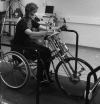Physical strain of handcycling: an evaluation using training guidelines for a healthy lifestyle as defined by the American College of Sports Medicine
- PMID: 23820153
- PMCID: PMC3758534
- DOI: 10.1179/2045772313Y.0000000127
Physical strain of handcycling: an evaluation using training guidelines for a healthy lifestyle as defined by the American College of Sports Medicine
Abstract
Objective: Developments in assistive technology such as handcycling provide attractive possibilities to pursue a healthy lifestyle for patients with spinal cord injury. The objective of the study is to evaluate physical stress and strain of handcycling against training guidelines as defined by the American College of Sports Medicine (ACSM).
Design: Seven able-bodied males conducted an incremental peak exercise handcycling test on a treadmill. In addition, two indoor treadmill (1.3 m/second with an inclination of 0.7% and 1.0 m/second with an inclination of 4.8%) and three outdoor over ground exercise bouts were performed (1.7, 3.3, and 5.0 m/second). One individual handcycled a representative 8-km-distance outdoors.
Outcome measures: Physical stress and strain were described in terms of absolute and relative power output, oxygen uptake (VO2), gross efficiency (GE), and heart rate (HR). Also, local perceived discomfort (LPD) was determined.
Results: Relative handcycling exercise intensities varied between 23.3 ± 4.2 (below the ACSM lower limit of 46%VO2peak) and 72.5 ± 15.1%VO2peak (well above the ACSM lower limit), with GE ranging from 6.0 ± 1.5% at the lower to 13.0 ± 2.6% at the higher exercise intensities. Exercise intensities were performed at 49.8 ± 4.2 to 80.1 ± 10.5%HRpeak. LPD scores were low to moderate (<27 ± 7).
Conclusion: Handcycling is relatively efficient and exercise intensities > 46%VO2peak were elicited. However, exercise load seems to be underestimated using %HRpeak. LPD was not perceived as limiting. Physiological stress and strain in able-bodied individuals appear to be comparable to individuals with a paraplegia. To understand individualize and optimize upper-body training, different training programs must be evaluated.
Figures
Similar articles
-
Handcycling: training effects of a specific dose of upper body endurance training in females.Eur J Appl Physiol. 2016 Jul;116(7):1387-94. doi: 10.1007/s00421-016-3395-x. Epub 2016 May 24. Eur J Appl Physiol. 2016. PMID: 27222003 Clinical Trial.
-
Effect of a 7-week low intensity synchronous handcycling training programme on physical capacity in abled-bodied women.J Sports Sci. 2021 Jul;39(13):1472-1480. doi: 10.1080/02640414.2021.1880171. Epub 2021 Feb 2. J Sports Sci. 2021. PMID: 33530865
-
Effects of an Upper-Body Training Program Involving Resistance Exercise and High-Intensity Arm Cranking on Peak Handcycling Performance and Wheelchair Propulsion Efficiency in Able-Bodied Men.J Strength Cond Res. 2020 Aug;34(8):2267-2275. doi: 10.1519/JSC.0000000000002738. J Strength Cond Res. 2020. PMID: 30024482
-
Biophysical aspects of handcycling performance in rehabilitation, daily life and recreational sports; a narrative review.Disabil Rehabil. 2021 Dec;43(24):3461-3475. doi: 10.1080/09638288.2020.1815872. Epub 2020 Sep 9. Disabil Rehabil. 2021. PMID: 32905740 Review.
-
Physiology of handcycling: A current sports perspective.Scand J Med Sci Sports. 2021 Jan;31(1):4-20. doi: 10.1111/sms.13835. Epub 2020 Oct 7. Scand J Med Sci Sports. 2021. PMID: 32969103 Review.
Cited by
-
Differentiated ratings of perceived exertion in upper body exercise.PLoS One. 2023 Mar 24;18(3):e0283620. doi: 10.1371/journal.pone.0283620. eCollection 2023. PLoS One. 2023. PMID: 36961835 Free PMC article.
-
Therapeutic efficacy of intensified walk training under the electrocardiogram telemetry in stroke induced lower limb dysfunction patients with heart failure.Int J Clin Exp Med. 2015 Sep 15;8(9):16599-605. eCollection 2015. Int J Clin Exp Med. 2015. PMID: 26629190 Free PMC article.
-
Steering Does Affect Biophysical Responses in Asynchronous, but Not Synchronous Submaximal Handcycle Ergometry in Able-Bodied Men.Front Sports Act Living. 2021 Oct 25;3:741258. doi: 10.3389/fspor.2021.741258. eCollection 2021. Front Sports Act Living. 2021. PMID: 34761216 Free PMC article.
-
Handcycling: training effects of a specific dose of upper body endurance training in females.Eur J Appl Physiol. 2016 Jul;116(7):1387-94. doi: 10.1007/s00421-016-3395-x. Epub 2016 May 24. Eur J Appl Physiol. 2016. PMID: 27222003 Clinical Trial.
References
-
- van der Woude LH, de Groot G, Hollander AP, van Ingen Schenau GJ, Rozendal RH. Wheelchair ergonomics and physiological testing of prototypes. Ergonomics 1986;29(12):1561–73 - PubMed
-
- Dallmeijer AJ, Ottjes L, de Waardt E, van der Woude LH. A physiological comparison of synchronous and asynchronous hand cycling. Int J Sports Med 2004;25(8):622–6 - PubMed
-
- Dallmeijer AJ, Zentgraaff ID, Zijp NI, van der Woude LH. Submaximal physical strain and peak performance in handcycling versus handrim wheelchair propulsion. Spinal Cord 2004;42(2):91–8 - PubMed
-
- Abel T, Rojas Vega S, Bleicher I, Platen P. Handbiking: Physiological responses to synchronous and asynchronous crank montage. Eur J Appl Physiol Occup Physiol 2003;3(4):1–9
-
- Abel T, Schneider S, Platen P, Struder HK. Performance diagnostics in handbiking during competition. Spinal Cord 2006;44(4):211–16 - PubMed
MeSH terms
LinkOut - more resources
Full Text Sources
Other Literature Sources
Medical

